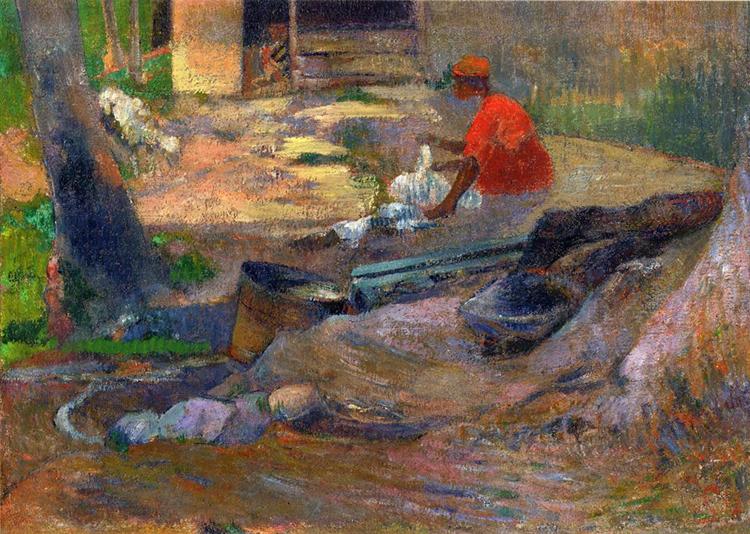תיאור
In A Little Washerman (1887), Paul Gauguin captures the essence of everyday life through the depiction of a child holding a bowl of laundry while standing against a background of striking shades of color. Typical of Gauguin's post-impressionist style, this work reveals his mastery of artistic perception and reimagining of the environment, characteristics that would later define his career.
The central figure of the painting, a small child, is depicted in a pose that contests the instantaneous interaction between the subject and his daily labor. In the composition, the child is not just a mere spectator of his surroundings; he is an integral part of the scene, emblematic of the working classes who defy the bourgeois conventions of the time. The character is anchored in the foreground, lit in a way that highlights his presence, while the background seems to blur with colors that oscillate between vibrant yellows and emerald greens, creating a sense of warmth and vitality that contrasts with the contemporary industrial world that Gauguin rejected.
The colors in “A Little Washerman” are a notable aspect that reveals the evolution of the use of color in Gauguin’s work. The palette is composed of warm and exuberant tones that evoke a sense of joy and simplicity. The way he combines color and form allows the viewer to recognize, albeit at an intuitive level, the importance of the child figure in the social context. Through the simplification of forms and the use of expressive color, Gauguin goes beyond the mere representational portrait to delve into the emotive and the symbolic.
The technique of thick, loose brushstrokes that characterises his works from this period is also present. This approach to a freer application of paint not only allows for greater liveliness in the representation of forms, but also reinforces the idea of the immediacy and reality of child labour. In this sense, the painting evokes a tension between the innocence of the child and the weight of his responsibilities, a recurring theme in the work of Gauguin, who was always interested in exploring the realities of the working classes.
The historical context of “A Little Washerman” and its creation is also essential. In the 1880s, Gauguin was searching for a personal voice that would set him apart from his contemporaries, moving away from Impressionism toward more symbolic and stylized art. This transition reflects his uneasiness with modernity and his desire to return to simpler ways of life. The work, often considered a glimpse into working-class life, opens the door to profound interpretations of childhood and work, issues that would be representative of the era.
Gauguin, an artist whose legacy lies in his ability to transform the everyday into vibrant and meaningful works of art, offers, in “A Little Washerman,” a reflection on the duality of life: joy and work, innocence and responsibility. This work is a clear testament to his artistic evolution and his constant search for a visual language that transcends simple representation, inviting the viewer to contemplate not only what they see, but what they feel in the face of the harsh reality that underlies the lives of workers. Thus, “A Little Washerman” perpetuates itself as an emblem of art that seeks to narrate life through a prism of emotion and color, giving voice to those whose stories often remain in the shadows of art history.
KUADROS ©, a famous painting on your wall.
Hand-made oil painting reproductions, with the quality of professional artists and the distinctive seal of KUADROS ©.
Painting reproduction service with satisfaction guarantee. If you are not completely satisfied with the replica of your painting, we will refund 100% of your money.

